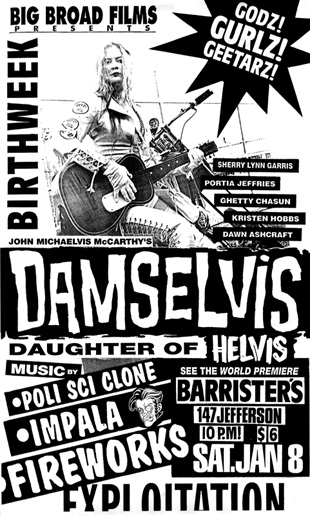
Comic Book | Soundtrack | Photo Gallery | Reviews | Helvis | Rebelvis | Psychedelvis | Cap'n Whiz | Tomb of Helvis
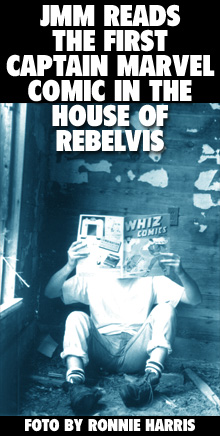
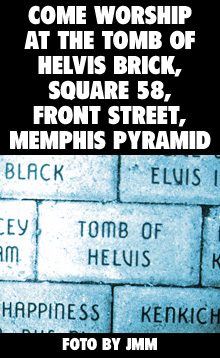


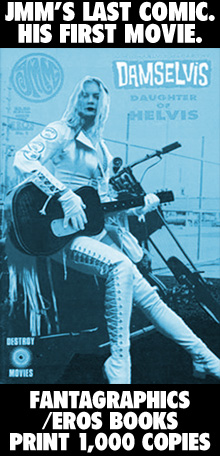
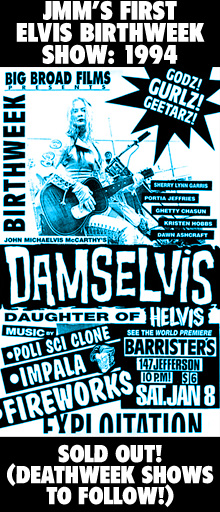
ORIGINS OF "VIS"
John Michael McCarthy kicked off his filmmaking career by writing and directing DAMSELVIS, DAUGHTER OF HELVIS in 1994. The project had started as a Fantagraphics comic book which was later published as a fumetti with photos and a "making of" article*(see article "Custom Filmmaking").
Fellow filmmaker Hugh Gallagher would shoot most of the movie on Super VHS. Cinematographer Darin Ipema would finish the job and assist photographer David Thompson with the edit.
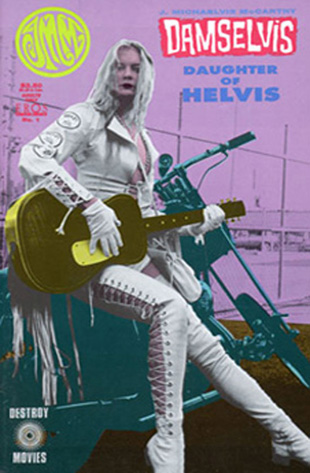
CUSTOM FILMMAKING
by Frank Grow
(writing for Hypno Magazine, 1994)
"Damselvis, Daughter of Helvis"
Warning: Do not watch J. Michaelvis McCarthy's DAMSELVIS without first reading the accompanying DAMSELVIS "Supermag". If you do, the impression of the film's opening scene - if you're able to sit through it at all - might be something like this:
Black Jesus, a guy cheaply costumed as a biblical era Jesus (except for his burgundy topsiders), and crowed with a wreath of twisted sticks, preaches to a very urban looking group of white people alongside a rural highway. Three strange crosses, possibly made from white-washed telephone poles, loom behind Black Jesus, as he stammer reads his sermon from a schroll, then asks someone to be the "lamb". A volunteer from the roadside congregation kneels in front of Black Jesus. A guy in a black leather jacket, gloves, and workmen's boots shoots the kneeling "lamb" in the head. The congregation remains calm. Two trendy pierced and tattooed heavy metal neo-punker deathrock chics in leather lingerie, appear from nowhere. The assassin kicks starts an old chopper and rides off. Meanwhile, Black Jesus stands over the dead lamb and says "All right my son." The lamb-man rises from the dead, fake bullet hole still intact on his forehead, looks to heaven and thanks the lord.
This no-budget, no-brain, no-nothing miracle launches the film's opening title sequence, and before you can stop it, DAMSELVIS slips through your fingers like a stinking slimy wriggling near-dead fish, Leaping from the fisherman's catch pail back into the it's polluted pond, the film acclimates to your video screen and pursues it's own perverted unnatural instincts. WIth out any apparent plot, the film blazes it's own crazy course through a diseased and littered sub pop-culture forest, like a tireless rambling amphetazmized lunatic escaped from the asylum.
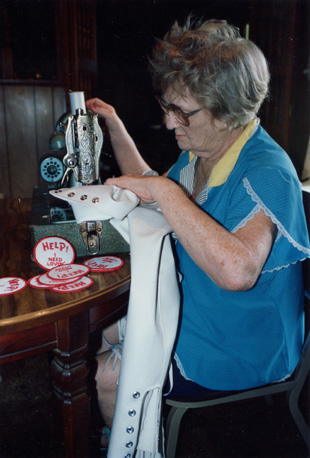
Mildred McCarthy makes the costume.
According to McCarthy, DAMSELVIS is an "exquisite piece of trash." All I could remember from my first viewing were a few tiny nuggets floating in a strange, degenerated, triple-B quality "shot on video" blur. Non-actors appear from nowhere, play unidentifiable characters, and speak indecipherable dialogue. A character named Evel Knievelvis, a balding blonde man sitting in an oxyacetylene welding tank cart wheelchair, with a cyber trash artificial arm (made from an old tire tread, some ducting, and a funnel) rambles about his failed stunt - a motorcycle jump over five steam rollers while playing guitar. During very soft-core lesbian scenes, naked women slash each other with bloody knives they pull from their pussies. Twenty-something year old women dressed as pig-tailed school girls, beat each other with giant lollipops in the backseat of a yellow school bus. Guitars stand alone on dark street corners, like pawnshop versions of the black megaliths in Kubrick's 2001 A SPACE ODYSSEY, emitting deafening feedback and triggering video hallucinations when characters touch their strings.
DAMSELVIS lurches toward it's ending like a dysfunctional speeding jumbo jet desperately trying to lift off a dead-end runway. But keep the faith baby, 'cause just when you're sure the plane is doomed to hit hte wall, it lifts, veers, and blazes into a bizarre new world. DAMSELVIS' totally classic custom trash ending begins in a dark museum basement. A human-size guitar -shaped Egyptian sarcophagus stands before a woman in leather butt-exposing shorts, lace-up boots, and a short waisted leather jacket with long long fringe hanging from the sleeves. The woman uses a live tarantula to re-animate the creature inside, plummeting the film into a super seedy mega-raunchy custom video-hell underworld. Over-saturated negativized colors flare, distorted waves of electric guitars screech, as HELVIS - a bug-eyed lump-lipped pompadoured zombie mummy wrapped in magnetic recording tape emerges. He fights Black Jesus - who reappears as a hissing, groaning, fork-tongued demonic wolfman - finally beating him to death with a vintage Silvertone electric guitar.

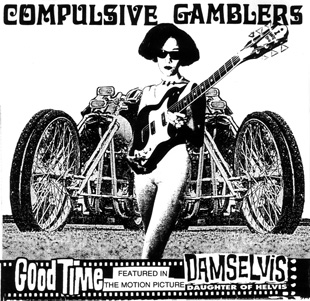
Then-just when you think you're finished, you realize you haven't even seen the magazine yet. You open it cautiously, not sure if you can take anymore trashed Elvisitic hellness. Your eye hovers over the black and white photo-crammed pages while you gather enough courage to dive into the text. Warning: don't expect the DAMSELVIS photo-comic magazine to soothe the sweltering lacerations inflicted upon your brain by the video's relentless whip-like lashings of confusion. The first paragraph, McCarthy's description of his video's first scene, reads:
"Making Something Out of Nothing... (The Making of Damselvis)
"Black Jesus gives an apocalyptic message to his few followers to show that he still has power, unaware that he is trapped in genre that unleashes 'repressed Christian desires.' A 'lamb' is chosen, killed, then raised from the dead. Then in a bitter act of resolution, Black Jesus fights fire with internal combustion and sends his three leather clad converts on a heaven-wish: To destroy the flowering daughter of Dionysis before she can raise Him from his pyramid tomb..."

JMM AS HELVIS. FOTO by JIM COLE.
Essentially, a "making of" essay, and, while it might not make the video any more compressible, the Damselvis supermag will totally transform your video viewing perception. Offering stories about the video's actors (their personal lives), locations, (how we either got or didn't get permission to shoot here), and the crew's bizarre encounters along the way, the magazine provides material to fill the video's gaping holes. Think of the video a a coloring book full of empty black outline drawings, and the magazine as a box of stained and broken crayons. Put the two together and ... genius! Watching the film after having read the mag, you won't see the actors as characters but as real people, each colored with the magazine's trashy tabloid-like real-life off-screen histories. The plot explanations even make some sense. Even the seemingly random appearance of actors is attributed to McCarthy's twisted premeditated logic:
"After years of seeing different actors play the same character from movie to movie, (Bond, Tarzan, etc.) I thought it would be cool to have different actors play the same character in a single movie, (there would have to be some metaphysical reason for this to avoid confusion), so when Susan said she was uncomfortable with doing nudity, I simply asked another model, Jennifer, if she could play that aspect of the character (though I still wanted Susan to have more screen time..."
The magazine (copyrighted as "Damselvis, Daughter of Helvis Supermag") also describes the crosses off the highway (from the opening scene) as monuments erected by a man in memory of a daughter who died in an auto accident. The special "Damselvis Pin-Up Page" features the film's FX man, Bob Gann, posin' in full Teen Beat style. There's even a photo collage chart printed inside the front cover linking all the film's vintage Silvertone guitars with each of McCarthy's incarnations of Elvis (there's Psychedelvis, Elvicious, Rebelvis, Hevlis, African-American Damselvis, European-American Damselvis, Evel Knievelvis and "Scott", each with his own "axe").
Remember those children's records like Jungle Book, Alice in Wonderland, Bozo the Clown, with two albums in a hinged book-like sleeve and pages of full color illustrations and printed lyrics that were meant to be read along with the record? Whether he meant it or no, by combining video with magazine, J. Michaelvis McCarthy has resurrected and re-invented a nearly extinct childhood entertainment medium - the read along record album - as a read along video.
Frank Grow
"Custom Filmmaking"
Hypno Magazine, 1994
